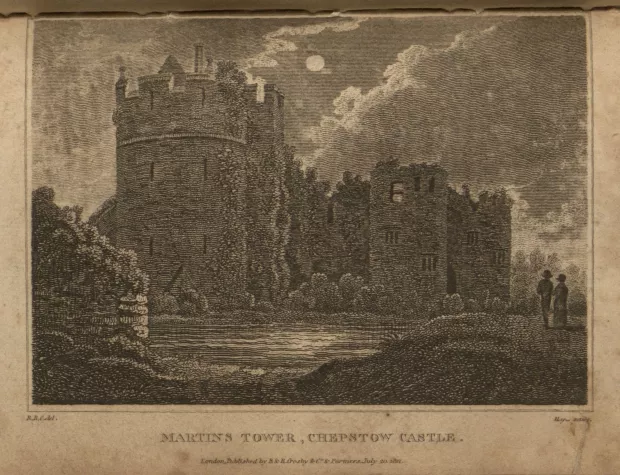Creation Date
1813
Height
8 cm
Width
11 cm
Medium
Genre
Description
The subject, Chepstow Castle, dominates most of the print, sitting across the water from the viewer. It is in a state of ruin: ivy climbs up the towers, and the tops of the rightmost towers are either severely damaged or missing. The sun appears above the castle, gleaming in a wide rift between the clouds. In the foreground, shrubbery frames the castle on the left; to the right, it is bordered by grassland and trees. Two persons stand in front of the trees.
The subject, Chepstow Castle, was the final great spectacle of the Wye Tour. The crumbling walls, juxtaposed with luxuriant plant life, ensured both an impression of picturesque decay and a subtle reminder of human mortality: the closed body language of the travelers in the right extremity of the print suggests that they are awestruck by the "sublime" scene before them, while the “setting sun” and rapidly crumbling castle evoke the ephemeral nature of life and beauty (Bloomfield 3.313).
The print’s significance, like many of the landscape pieces of the day, is perhaps most evident in its picturesque subject. By examining a work of human architecture that has succumbed to the ravages of nature, the engraver is addressing the Romantic notion of the picturesque. The theme of mortality (established by the setting sun) suggests that the viewer of the ruins is evaluating himself rather than the castle’s picturesque qualities, and is therefore following in the footsteps of Wordsworth. In Wordsworth’s poem “Lines composed a few miles above Tintern Abbey, on revisiting the banks of the Wye Valley during a tour, July 13, 1798,” “memory and association are even stronger influences on [the poet’s] feelings . . . than is the impact of the physical scenery itself” (Andrews 86). This examination of one’s self rather than the landscape “launch[ed] a new phase in man’s relationship with the natural world, on the spot where, a generation earlier, Picturesque tourism itself was launched” (Andrews 86). By focusing on the self, rather than whether or not a scene is “correctly Picturesque," Bloomfield was embracing a shift in the way the natural world was viewed—less as a work of art to be judged, and more as a conduit to one’s innermost thoughts and feelings (Gilpin 18). This shift is a fundamental tenet of Romanticism as we understand it today.
Associated Works
Locations Description
The Wye River
The Wye River rises on Plynlimon Mountain in Wales and flows southeast for 130 miles. The last forty miles of the river, beginning at Ross-on-Wye, made up the Wye Tour during the eighteenth and nineteenth centuries. Gilpin described its beauty as related primarily to its “mazy course” and “lofty banks” (Gilpin 7). The river winds along the English-Welsh border until it empties into the River Severn at Chepstow, and features the ruins of several castles, abbeys, and the like along its banks.
Chepstow Castle
Built in 1067 near modern Chepstow in southeast Wales, the ruins of Chepstow Castle served as a fitting finale for the Wye tour. Tourists had already strolled through Tintern Abbey and observed Goodrich Castle from afar, and the third great ruin of the tour tied the trip together nicely. Chepstow Castle’s decrepit towers and swiftly disintegrating walls likely served to call mortality and the irreversible flow of time to the minds of viewers, and the plants that crept over its outer façade ensured its evocation of picturesque decay.
Chepstow
Located approximately two miles above the junction of the rivers Wye and Severn, Chepstow was the final stop on the Wye Tour. Its most magnificent, picturesque view is undoubtedly Chepstow Castle, which served as the last great spectacle of the Wye Tour.
Copyright
Copyright 2009, Department of Special Collections, Memorial Library, University of Wisconsin-Madison, Madison, WI
Collection
Accession Number
PR4149 B6 B3 1813
Additional Information
Bibliography
Andrews, Malcolm. In Search of the Picturesque. Stanford: Stanford UP, 1989. Print.
Bloomfield, Robert. The Banks of Wye: a Poem in Four Books. London: Longman; Hurst; Rees; Orme; etc., 1813. Print.
Gilpin, William. Observations on the River Wye. 1782. Oxford: Woodstock Books, 1991. Print. Revolution and Romanticism, 1789-1834.
Kaloustian, David. “Bloomfield, Robert (1766–1823).” Oxford Dictionary of National Biography. Online ed. Ed. Lawrence Goldman. Oxford: OUP, 2004. 21 Aug. 2013.
Moir, Esther. The Discovery of Britain; The English Tourists. London: Routledge & K. Paul, 1964. Print.

